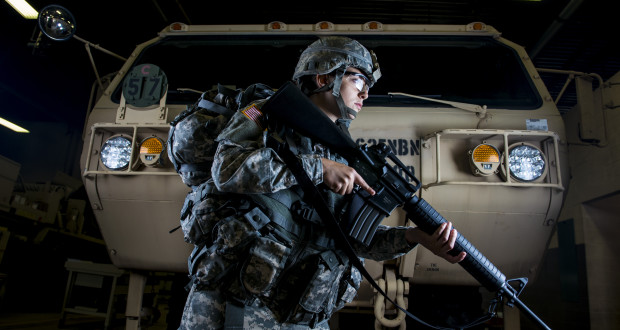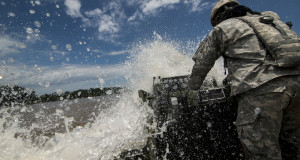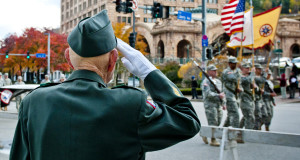PLAINFIELD, Ill. – Every time a news article announces a woman’s achievement in the military, the Internet goes ablaze with two main types of responses.
The “You go girl” camp cheers on with optimism and support, mostly carried forth by women, but also chanted by men embracing their sisters in arms.
Then there’s the “I can’t believe what’s happening to my Army,” camp. Often, this party responds in full shock, horror, disbelief, sometimes followed by head trauma and emotional outbursts. Oh, the dismay! The utter corruption going on before our eyes!
And the memes that follow are priceless. One in particular depicts a man laughing, drinking from a bottle (while driving, no less) with the caption, “So (freaking) glad I’m out.”
Hmmm.
And yet there’s another group in the mix. Usually this camp is quieter. More reserved. Less ostentatious.
This group doesn’t raise a fist, but a finger, asking the question, “Is this really a news story?”
After all, women have served in the battlefield along men as early as the Revolutionary War. At that time, such women were known as “Molly Pitchers.” The title was coined for women who brought water to cool off the cannons. Then it expanded as an emblem of women who served as spies or fought as Soldiers disguised as men.
The Army’s history is rich of women’s firsts. First commissioned (1950). First general officers (1970). First in command over men (1971). First Silver Star recipient (2005). First Best Warrior winner (2010). Some of the “firsts” going on today are less monumental than the ones preceding them, while others carry a heavier load. Yet all of these moments, together, form a longer narrative on the historical line of women in uniform.
It was only in 1978 that the Women’s Army Corps was deactivated and women began training together with men in the same army. Today, Women are integrated in ways thought impossible 40 years ago. Approximately 30,000 combat positions began opening to women in 2014, with more on the way in the next few years.
These women, who volunteer to fight on the battlefield, are no Barbie dolls.
“We don’t join the Army for our looks. We join the Army for the training, for the sacrifice to our country. I didn’t join the Army to have people look at me, to have people feel sorry for me, so (that) people can think I’m a Barbie,” said Sgt. 1st Class Donna Vance, of New Haven, Connecticut.
Vance is now a recruiter for the New York Recruiting Battalion with 17 years of service and two deployments, both to Iraq (2003 and 2008). Yet, she’s noticed the raised eyebrows when others hear she deployed as a technical engineer.
A construction job.
Engineering and construction are for boys. Not girls. Right?
Tell that to the Kentucky Speedway, where Vance worked as a main technician for the project as a civilian. She’s also worked on the Cincinnati Reds stadium and performed drill testing and land surveying for an engineering firm.
Vance said despite her credentials, training and background, women in the Army are still expected to prove themselves when they show up to a new assignment.
“I work in the field with men all the time, and then on my last deployment, I actually had a lot of people who were very shocked and surprised that I knew engineering stuff,” said Vance.
Other than the constant doubts women face for doing “male jobs” in uniform, there are other challenges to “Serving While Woman.”
Some challenges are more humorous than others.
Like the time Staff St. Katherine Goodwin, now a medic with the 374th Engineer Company (Sapper), in Concord, California, brought a breast pump to a field training exercise.
She was still nursing her first child at the time but was cleared to train with her company. Whenever she plugged the pump in her tent, the surge tripped the field generator, cutting off power to all the surrounding tents. Moans and groans would erupt from her camp neighbors.
“What the heck?”
“Not again!”
“What is going on?”
But if she hid away to other areas that were less private – even with a warning sign posted – undoubtedly a male Soldier would stumble in. Upon discovering her, his face usually filled with horror, and he’d trip over himself in embarrassment.
Then there’s the issue of the uniform itself. One ballistic vests worn in combat come with a triangular “crotch shield” that is rather useless – even for men – but especially cumbersome for women when going to the bathroom.
Oh, and maternity uniforms.
Pregnant women are not allowed to deploy, but they can still train in the field at the commander’s discretion. Units can order maternity uniforms, but the ordering system is so inefficient that they typically arrive just after the baby is born.
“Well. If the Army wanted you to have a baby, it would have issued you one,” said every Internet troll in response.
Hardy har har. That’s funny.
Women are authorized 30 days to recover from pregnancy. Forty-five days if it’s a C-section with their abdomen muscles stitched back together. They get six months total to recover and pass the Army Physical Fitness Test (APFT).
“I had a C-section and I physically had every muscle in my stomach cut open and sewn back together, and I wasn’t even allowed to sit up for 45 days on my own,” said Vance, who strives to score a perfect 300 on every APFT.
Beyond the snarkiness or doubts women face among their ranks, they also face cultural challenges with international partners.
On a deployment to Afghanistan (2011-2012), Army public affairs journalist Staff Sgt. Nazly Confesor recalls an article she was assigned to write on an Australian Stryker unit.
She went out on a mission with them to take photos, but came back with nothing. She was stuck inside their Stryker for three hours and told she couldn’t leave the vehicle.
“What do you mean, I’m staying here?” she asked.
“He would not let me out. And I was there three hours, almost four hours, in the Styrker … and when I got back, I was pissed. They wouldn’t give me any reason.”
On the same deployment, she embedded with the 25th Infantry Division for two weeks at a combat outpost to write another story.
She was the only woman in the group. She slept in the aid station because there wasn’t anywhere else for her. They dedicated a time for her to shower with a guard at the entrance. But she doesn’t begrudge those arrangements. In fact, she said she felt guilty for imposing herself.
Initially, Soldiers weren’t sure whether or not she could keep up with their road marches. Their infantry up-tempo. But she showed she could hang.
“It became a norm to be part of them. I became their sister,” said Confesor, now living in Washington, D.C.
Also, being involved in an IED blast and a firefight didn’t hurt her image.
Still, it was hard to do her job as a woman in a country where cultural norms clashed with her identity. She wore shawls on missions, and tribal members wouldn’t shake her hand. She understood this as a sign of cultural respect, but it was still hard to get over the refused handshakes at first. Some Afghan security force members wouldn’t talk to her for interviews she needed. She placed her bun into her helmet to avoid attracting attention or become a target on patrols.
“That was my main concern,” she said about the mission. “I didn’t want to put myself or anyone else in danger.”
Her main concern wasn’t the fact she couldn’t wear glossy lipstick, paint her toenails, or giggle over fashion and gossip magazines. Though, admittedly, she missed some of those things being the lone woman at times.
Her focus was on the mission, not makeup.
That’s true for other women as well.
“I’m not on that bandwagon, like, I’m trying to be a man, or say that I’m better than a man,” said Sgt. Maj. Tanya Hudnall, who is now the equal opportunity adviser for the 4th Brigade, 95th Division (Initial Entry Training).
“But (I want) to show them that, hey, we can fill your shoes. We don’t want to be men, but we are tough. Mentally. Physically.”
Physically.
That is the main wedge dividing men from women in uniform. Not just their anatomy, but their physical abilities. Men are generally stronger, faster, than women. Each woman interviewed for this story admitted this. Though what they want to see is each woman get the opportunity to prove herself for the job on an individual basis. After all, that’s how men are judged whether or not they can join Special Forces or earn any other elite tab: By proving themselves.
“Give the position to the person who legitimately earned it,” said Hudnall, who lives in Milwaukee, Wisconsin.
No matter the gender, color or cultural background.
Really, that’s what the Army’s equal opportunity program is about.
The uniform is intended to mask those superficial differences and level the plane for each Soldier to do the best job possible. One of the Army values is selfless service. This is more than a sacrifice of time away from family or personal amenities on deployment. It’s a call for Soldiers to shed their personal distinctions for the sake of a unified force. The nametapes stay, and each Soldier might wear a different sized helmet or pair of boots, but every set of ACUs reads “U.S. Army” on the left pec.
“We joined the Army to be a Soldier not to be a Barbie,” said Vance. “I mean if we wanted to be Barbie, we’d be walking down a runway. We wouldn’t be out on the battlefield shooting guns, protecting our battle buddies.”
 Michel Sauret – Award-Winning Army Journalist | Independent Author Award-Winning Army Journalist, Independent Author
Michel Sauret – Award-Winning Army Journalist | Independent Author Award-Winning Army Journalist, Independent Author







When females are able to pass the Marine IOC, have the same PFT standards, be required to register for Selective Servivce, and stop complaining about unfair standards for Combat Arms – then come back and talk.